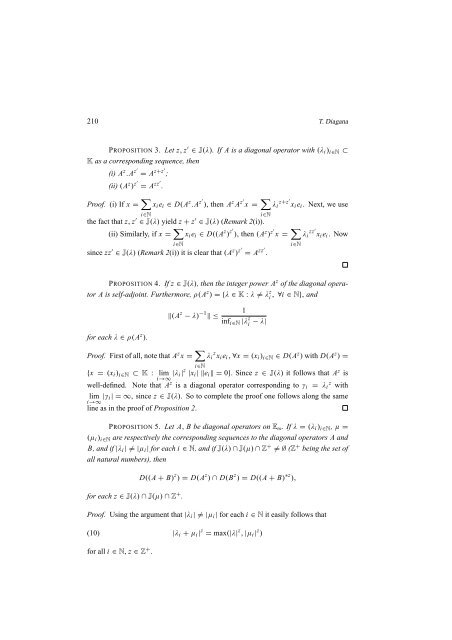T. Diagana INTEGER POWERS OF SOME UNBOUNDED LINEAR ...
T. Diagana INTEGER POWERS OF SOME UNBOUNDED LINEAR ...
T. Diagana INTEGER POWERS OF SOME UNBOUNDED LINEAR ...
You also want an ePaper? Increase the reach of your titles
YUMPU automatically turns print PDFs into web optimized ePapers that Google loves.
210 T. <strong>Diagana</strong><br />
PROPOSITION 3. Let z, z ′ ∈ J(λ). If A is a diagonal operator with (λ i ) i∈N ⊂<br />
K as a corresponding sequence, then<br />
(i) A z .A z′ = A z+z′ ;<br />
(ii) (A z ) z′ = A zz′ .<br />
Proof. (i) If x = ∑ x i e i ∈ D(A z .A z′ ), then A z A z′ x = ∑ z+z<br />
λ ′ i x i e i . Next, we use<br />
i∈N<br />
i∈N<br />
the fact that z, z ′ ∈ J(λ) yield z + z ′ ∈ J(λ) (Remark 2(i)).<br />
(ii) Similarly, if x = ∑ x i e i ∈ D((A z ) z′ ), then (A z ) z′ x = ∑ zz<br />
λ ′ i x i e i . Now<br />
i∈N<br />
i∈N<br />
since zz ′ ∈ J(λ) (Remark 2(i)) it is clear that (A z ) z′ = A zz′ .<br />
PROPOSITION 4. If z ∈ J(λ), then the integer power A z of the diagonal operator<br />
A is self-adjoint. Furthermore, ρ(A z ) = {λ ∈ K : λ ̸= λi z , ∀i ∈ N}, and<br />
for each λ ∈ ρ(A z ).<br />
‖(A z − λ) −1 ‖ ≤<br />
1<br />
inf i∈N |λ z i − λ|<br />
Proof. First of all, note that A z x = ∑ i∈N<br />
λ i z x i e i , ∀x = (x i ) i∈N ∈ D(A z ) with D(A z ) =<br />
{x = (x i ) i∈N ⊂ K : lim |λ i| z |x i | ‖e i ‖ = 0}. Since z ∈ J(λ) it follows that A z is<br />
i→∞<br />
well-defined. Note that A z is a diagonal operator corresponding to γ i = λ z i with<br />
lim |γ i| = ∞, since z ∈ J(λ). So to complete the proof one follows along the same<br />
i→∞<br />
line as in the proof of Proposition 2.<br />
PROPOSITION 5. Let A, B be diagonal operators on E ω . If λ = (λ i ) i∈N , µ =<br />
(µ i ) i∈N are respectively the corresponding sequences to the diagonal operators A and<br />
B, and if |λ i | ̸= |µ i | for each i ∈ N, and if J(λ) ∩ J(µ) ∩ Z + ̸= ∅ (Z + being the set of<br />
all natural numbers), then<br />
for each z ∈ J(λ) ∩ J(µ) ∩ Z + .<br />
D((A + B) z ) = D(A z ) ∩ D(B z ) = D((A + B) ∗z ),<br />
Proof. Using the argument that |λ i | ̸= |µ i | for each i ∈ N it easily follows that<br />
(10) |λ i + µ i | z = max(|λ| z ,|µ i | z )<br />
for all i ∈ N, z ∈ Z + .














